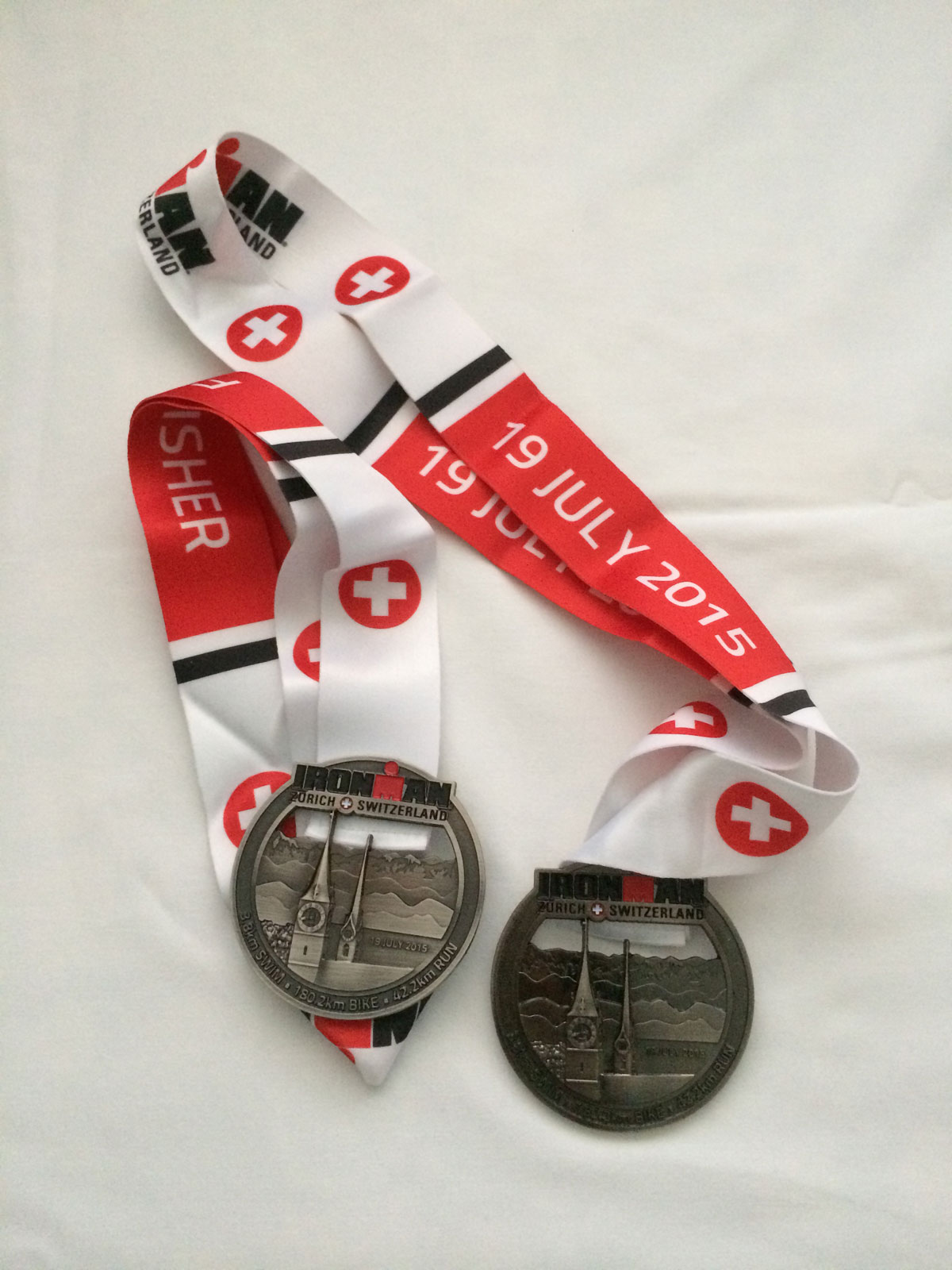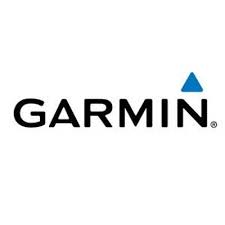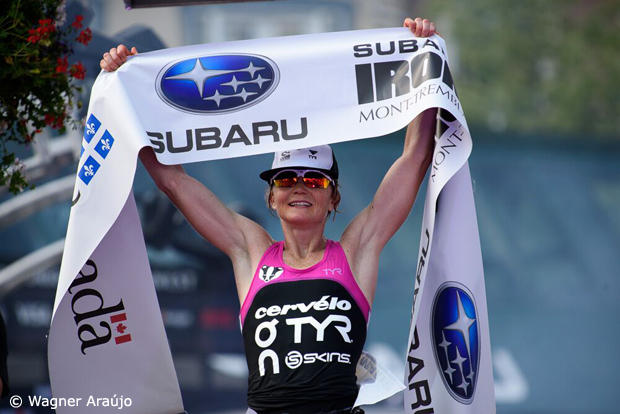“When someone can turn around their personal worst and make it a win, this is the true test of character.” — AJ Morrison (coach)
Ironman Switzerland is a fantastic race with a breathtaking course that can test the limits of any athlete. It’s no surprise that it’s one of the oldest IM races. But this year’s heat wave in Europe made the race especially tough – 10% of Greg’s field DNFed and 15% of mine did too. Thankfully, we both finished within the 16 hour timeline; here’s how it all unfolded.
The Swim:
The first day we arrived in Zurich, we went down to the race venue to register and take a quick dip in Lake Zurich. The water was refreshing – and so clear that you could see fish swimming at the bottom. But the beauty couldn’t take away from one key element; it was way too warm. The night before the race, Ironman announced that wetsuits were prohibited because of the temperature.
Thankfully, Greg had purchased swim skins for us to use (just in case). Though I never tried it until Zurich, and had no idea if it would help, I was relieved. Jumping into the water on race morning, I had a mental edge on other athletes, especially those who relied on wetsuits. This season, I had focused a higher amount of my training on long distance in the pool, and was so grateful that I had finished my last big workout – a 2x 2000m swim – just a week earlier. It was exactly what I needed for preparation.
I entered the water with my age group, and found that after the 4th buoy, the crowd thinned and I found room in the water. That never happens for me. I kept my pace (actually getting faster and more efficient as the race went on), realizing that I could pace/sight off a pretty fast breast stroke swimmers and minimize the chance of going off course. I took a GU at the Australian exit (i.e. the little island you ran across after mile 1, before jumping back into the lake to complete the swim.) When I got out of the water and felt really good about my time and my fitness. If I hadn’t done as much distance as I had in the latter months of training, there’s no way I could have felt that good, especially without a wetsuit.
The Bike:
Before I spend some time on the day, let me first describe the course. It is pretty amazing because it has something for everyone: roughly 15 miles of flat roads along the lake, then a few really challenging climbs (most notably the Beast, which is a 3-4 mile climb that apparently gets as steep as 13%, and then Heartbreak Hill, which is shorter, at maybe 1/3 mile, but has a more dramatic series of climbs.) And, then some fast descents that are challenging, but nothing like Lake Placid.
This year, the bike was the tale of 2 loops. The first loop was great — I paced well on the flats, keeping about 70% effort (which was the strategy that worked well for me at IMs Lake Placid and Maryland). I climbed well without killing my legs, and I took the speed on the descents. I even passed riders on Heartbreak Hill without even trying. I saw my mother, and the folks from Endurance Sports Travel (huge shout out to Caryle for applying sunscreen while I comped my bag of cheddar chips!)
However, the heat came out on the 2nd loop and it just became a brutal day. Headwinds the whole way around. There was no shade so the course was unforgiving. Climb 2 of the Beast (roughly 2/3 of the way through the ride) was “a Bastard” as someone else said. I’ve never seen anything like it. At least a dozen riders stopped midway on the climb, pulling over on the side of the road to puke, or stop to lower their heart rate, or just rehydrate. Residents were dumping buckets of water on riders as they rode by (I passed, as I loathe wet socks) but I did go through some sprinklers. I think the 2nd loop took me at least 45 minutes longer than the first, which is sad because I had been pacing well. It was almost an hour longer on the bike than I expected, but in retrospect, respectable.
Nutrition:
From a nutrition standpoint, I was really good, and hyper focused on staying with bars as long as I could, and getting as much salt in as I could. I kept to my bar strategy of 1 every 15 miles, and switched to gus at mile 85. I increased my salt intake to 3 or 4 per 10 miles when I noticed that my usually bony fingers were becoming mildly swelled (an informal proxy, but accurate). That seemed to work, and I tried to focus on getting Accelerade in, but with the heat, the extra intake of water I needed, and the extra time on the bike, I couldn’t find a way to make that work and keep my stomach on track. So, I got ~2.5 of the 4 bottles down.
The cutoff times (and the near downfall):
So, I’m not exactly a strong IM competitor, but I’ve never had to think about the cutoff times. This was such a mental game. I was watching my Timex watch relentlessly during the bike, realizing that I was losing time, and knowing that I had only 10 hours to finish the swim and bike. I did the math 100 times before race day, and knew that there was very little chance of me getting pulled from the race, but it’s so painful to feel like you’re under the gun. Because Switzerland has a 16 hour limit, it became a major consideration on race day. After I came through town and got to Heartbreak Hill (again, not a problem climbing after tired legs) I had to push it for the last few km to make sure that I got to the transition in time. Somehow, I remembered 9:45 as the time (which actually was a pre-Heartbreak Hill cutoff) and I was close.
My time doesn’t show it, but I raced through transition and took only the bare essentials — we all had to rack our own bikes, and that’s what took the most time. I was so thankful that my coach suggested that I pack a water bottle, because that was my saving grace. I grabbed it and my entire ziplock bag of gus, salt tablets, extra contacts, advil, etc. and ran from the tent. I didn’t selectively pick (as I usually do); I just grabbed it all.
The Run:
The run was a total mind and body game. Thankfully, in addition to my Timex watch (tracking overall race time) I also grabbed my Garmin and had started the GPS search function in transition. About 1/4 mile into the marathon, the tracking kicked in. So, there I was: 2 watches — one for overall time and one for run pacing — and two hands full with a water bottle and a ziplock bag of goods. I looked ridiculous, but I didn’t care.
I struggled on the beginning of the run. My stomach was out of sorts, probably less from the heat and race muck that happens, but more from the fear of not being able to finish. I had calculated my minimal run pacing when I was on the bike (translation, bad race math), and had computed that I needed to keep 13 min miles in order to finish in 16 hours. I was ok on the first 2 miles, but the 3rd was 45 seconds too long, and that really scared me. I felt awful, and was scared and stressed, and quickly jumped through all the emotions that come into play.
I just couldn’t run for more than a few minutes at a time. And when I say a few, I mean 2-3. Five was a stretch. At least I can walk fast. I saw Greg around mile 3.5 (who wasn’t that far ahead of me and actually looked really good, but apparently was struggling too) and told him I didn’t think I would finish in time. He gave me a confident “You will finish” and I started to wonder how he thought that.
I passed an aid station with an EMT and I wondered if I should just go in and tell them I couldn’t finish. My mind was a mess, and I was guzzling water like crazy. Why put my body through a marathon if I knew it was mathematically impossible to finish in time? Then, something strange happened. I realized that I was shorting myself one hour in my calculations — that I had 6 hours to run the marathon, not 5. Somehow, I looked at my Timex and determined that if I could get finish the first 10k, and still leave myself 5 hours to run 20 miles, that I could make it work. Even at a run/walk pace of 15 minute miles (which I knew I could do and the Garmin could show), that I could still finish in time. It would be close, but I could do it.
At that point, I started focusing on faster walking, more running, and keeping up with my nutrition. I figured out that while I drank more than usual, and kept my relative fluid/salt intake in check on the bike, that I actually still didn’t drink enough. I was so thirsty and refilled my water bottle at every other aid station. I was keeping track of my puffy fingers and taking more salt tables than usual. Probably 6 an hour. When I was near the end of the extra salt tablets from special needs, I started grabbing salt packets from the aid stations too. I kept up with my Gus, about every 3-4 miles and was so glad I packed extra salted caramel (my favorite, and go-to) so that I didn’t take any food from the aid station. I just worked my plan, and it paid off.
At every mile, I tracked my time and made sure that if I was over 13 miles/hour, that I ran more of the next mile. I was just exhausted but finally started to enjoy myself a bit more. I wasn’t scared (finally) but instead super determined. The run signs in km didn’t help me one bit. Even though they had 4 different km checkpoints on each sign, for each of the 4 loops of the run, they didn’t mean anything to me. Converting km to miles wasn’t in the cards anymore. I was done with bad race math. I couldn’t even remember how many km there were in a marathon. In fact, at one point, I asked someone I was passing to verify that a marathon in Europe was the same distance as in the States. (Um, yes, very dumb question.)
Even so, I have to say, I fared so much better than others. People, who on the outside looked like they were more fit than I am, were dropping from the run course (literally, several racers per mile were lying on the side of the road). It was a busy day for medical.
When I came around for my last 6 mile loop, the volunteer stressed to me that I had 2 hours to complete the race (again, I’ve never had to think about cutoffs, so this was all new.) I confirmed to myself that all I needed was 90 minutes and I could finish. I should have a 30 minute cushion. I ran/walked pretty quickly and just started passing people. It was getting dark and the aid stations were starting to close down. I realized that I would be one of the last to finish. When I made the last turn to on the run, and headed back for the last ~2.5 miles, I started running, and ran the whole way back. I hadn’t run a full mile all day, but after I started, I wouldn’t let myself stop. I must have passed 30 people in those miles.
The Finish:
It was a great feeling at the end — as it always is — and there was a part of me who enjoyed being in the spotlight at the Finisher’s Party as I crossed the finish line. But, I would much preferred an hour less, and a lot fewer people, at my finish.
Ironically, in the end, I felt pretty good and think the one of the main reasons that I made it was because I paced myself on the run and focused on keeping my heart rate and nutrition in check, in spite of the conditions. The course was incredible and I would certainly recommend it to others. But, just finishing — even if it was a personal worst — was a victory. Ironman #6…check. See you again someday. Just not in 2016.




